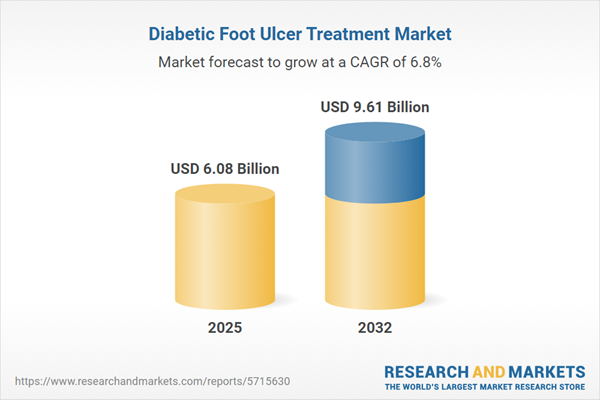Speak directly to the analyst to clarify any post sales queries you may have.
The diabetic foot ulcer treatment market is experiencing substantial advancement and transformation, shaped by emerging therapies, evolving technologies, and shifts in healthcare delivery. Senior decision-makers are navigating complex forces as they seek strategic opportunities across care modalities and regional landscapes.
Market Snapshot: Diabetic Foot Ulcer Treatment Market Size and Growth
The diabetic foot ulcer treatment market grew from USD 5.69 billion in 2024 to USD 6.08 billion in 2025. It is expected to continue growing at a CAGR of 6.76%, reaching USD 9.61 billion by 2032.
Scope & Segmentation
This report delivers a comprehensive assessment of the diabetic foot ulcer treatment landscape, providing actionable intelligence across core segments, delivery channels, and regional dynamics.
- Product Types: Alginate dressing, film dressing, foam dressing (including polyurethane foam and silicone foam), hydrocolloid dressing, hydrogel dressing
- Mode of Treatment: Debridement, growth factor therapy (platelet derived and recombinant), infection management (antibiotic and antiseptic agents), offloading, skin substitutes (biological and synthetic)
- End Users: Home care, private and public hospitals, specialty clinics, wound care centers
- Wound Types: Infected, ischemic, neuroischemic, neuropathic, noninfected
- Distribution Channels: Hospital pharmacy, online pharmacy (via mobile applications and web portals), retail pharmacy
- Regions: Americas (North America and Latin America), Europe, Middle East & Africa, Asia-Pacific
- Companies Covered: Smith & Nephew plc, 3M Company, ConvaTec Group Plc, Mölnlycke Health Care AB, Coloplast A/S, Integra LifeSciences Holdings Corporation, Johnson & Johnson, Becton Dickinson and Company, Merck KGaA, Baxter International Inc
Key Takeaways
- Advancements in biomaterials, growth factor therapies, and digital monitoring are reshaping wound management standards and expanding therapeutic options.
- Integrated delivery systems and telemedicine are driving accessibility, with remote monitoring enabling earlier interventions and improved patient adherence.
- Strategic alliances between device manufacturers, biopharmaceutical firms, and digital health companies are accelerating the launch of domain-specific innovation pipelines.
- Regional disparities in reimbursement, infrastructure, and specialist access directly influence the adoption speed and configuration of advanced care models.
- Investment in local manufacturing and supply chain resilience is rising, in response to policy and tariff uncertainties affecting raw material sourcing and costs.
Tariff Impact on Supply Chain and Innovation
Anticipated US tariff adjustments in 2025 are projected to impact the cost structure for imported wound care supplies and devices. Manufacturers that source critical components globally may face higher input costs, which could influence pricing and adoption of advanced products, particularly in cost-conscious care settings. The sector is responding by exploring alternatives such as nearshoring, domestic production, and deeper collaborations with contract development partners, supporting long-term resilience and innovation readiness.
Methodology & Data Sources
Analysis in this report leverages a multilayered research approach, combining quantitative data from regulatory, clinical, and procurement databases with qualitative insights from expert interviews, clinician surveys, and stakeholder forums. This robust validation ensures reliability and actionable guidance for market entrants and incumbents.
Why This Report Matters
- Provides senior decision-makers with granular market segmentation to inform investment and product development strategies.
- Delivers insight into regulatory adaptations, reimbursement models, and supply chain shifts that directly affect market access and profitability.
- Highlights technological innovations and cross-sector partnerships that are shaping patient outcomes and future market direction.
Conclusion
Continuous innovation and strategic adaptation are redefining the potential of diabetic foot ulcer therapies. Market participants equipped with timely intelligence and segment-specific insight are best positioned to excel as patient needs and clinical imperatives evolve globally.
Additional Product Information:
- Purchase of this report includes 1 year online access with quarterly updates.
- This report can be updated on request. Please contact our Customer Experience team using the Ask a Question widget on our website.
Table of Contents
3. Executive Summary
4. Market Overview
7. Cumulative Impact of Artificial Intelligence 2025
Companies Mentioned
The companies profiled in this Diabetic Foot Ulcer Treatment market report include:- Smith & Nephew plc
- 3M Company
- ConvaTec Group Plc
- Mölnlycke Health Care AB
- Coloplast A/S
- Integra LifeSciences Holdings Corporation
- Johnson & Johnson
- Becton Dickinson and Company
- Merck KGaA
- Baxter International Inc
Table Information
| Report Attribute | Details |
|---|---|
| No. of Pages | 196 |
| Published | October 2025 |
| Forecast Period | 2025 - 2032 |
| Estimated Market Value ( USD | $ 6.08 Billion |
| Forecasted Market Value ( USD | $ 9.61 Billion |
| Compound Annual Growth Rate | 6.7% |
| Regions Covered | Global |
| No. of Companies Mentioned | 11 |









